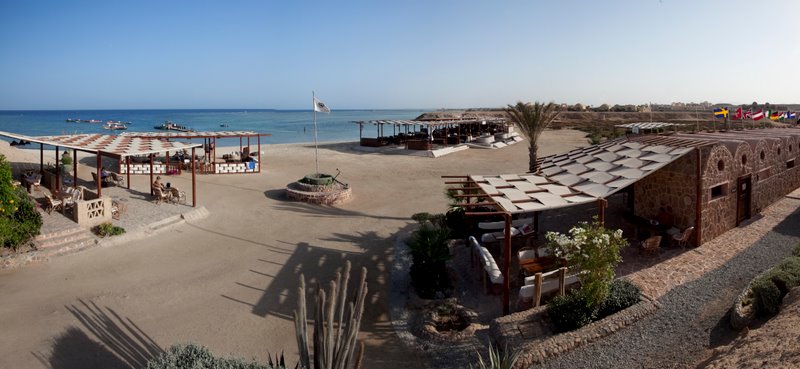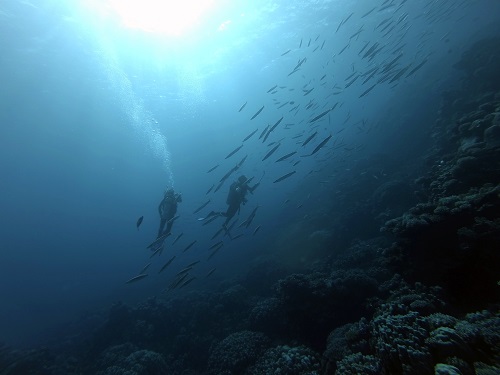News
The most chilled out diving in the Red Sea?
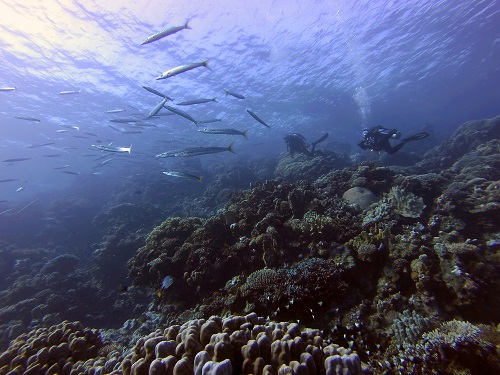
While relaxing on the beach at Marsa Shagra recently it occurred to me that this was the fifth time I had visited this charming and relaxed dive destination. This is very unusual for me; with so many places to visit in the world, I rarely go back to the same place twice.
But Marsa Shagra is rather special. I always say that although it might not offer the very best diving in the Red Sea (for that you probably want to take one of the liveaboards to the offshore reefs), it certainly does offer the most chilled out.
Once you have checked in and been checked out by one of the dive guides, you are free to dive on the house reef any time you like. No need for a guide. So it is perfectly possible to find yourself and your buddy all alone on what must be one of the best preserved house reefs in Egypt.
Successive Egyptian governments have pressured the owners of the village to expand, but they have always resisted. The result is that the house reef is in excellent condition with fewer divers visiting it than might otherwise be the case. This ecological outlook (they describe themselves as an ‘Eco-village’) is evident throughout the operation – everyone there is concerned with the welfare of the reefs and marine life, which is a delight to see.
Another thing that makes Shagra an ideal venue is the range of diving available. As well as the house reef there are excursions by truck up and down the coast to visit numerous other shore diving sites. There are also speedboat dives out to sites offshore, including Elphinstone Reef, where it is possible to see large pelagics. While we were there, others (not us unfortunately) saw oceanic white tips and even a whale shark. We were lucky enough to see the mythical Dugong not far from Marsa Abu Dabab though, so we couldn’t complain.
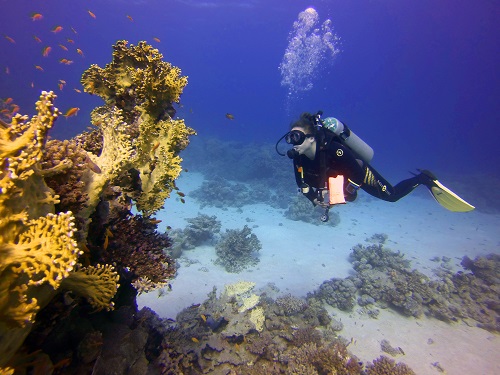 Booking onto dives seems complicated to begin with, but in reality is simple. Just go to the dive centre, check in on the computer screen and see what excursions are available for the following day – easy! Some dives require a minimum number for a trip to go ahead, but that is rarely a problem even when the village is quieter. On this visit I was in a small group of four. We all wanted to visit Abu Ghusun, a very pretty reef with one of the few wrecks in that part of the Red Sea. It’s a great dive, but many people seem to be put off by the hour-and-a-half drive involved. After three days of trying with no luck (just the four of us were booked on and the minimum required was ten), the dive manager took pity on us and agreed to run the trip for just us! That was a result, especially since it turned out to be my first dive of 2015 – and my 1000th dive to boot.
Booking onto dives seems complicated to begin with, but in reality is simple. Just go to the dive centre, check in on the computer screen and see what excursions are available for the following day – easy! Some dives require a minimum number for a trip to go ahead, but that is rarely a problem even when the village is quieter. On this visit I was in a small group of four. We all wanted to visit Abu Ghusun, a very pretty reef with one of the few wrecks in that part of the Red Sea. It’s a great dive, but many people seem to be put off by the hour-and-a-half drive involved. After three days of trying with no luck (just the four of us were booked on and the minimum required was ten), the dive manager took pity on us and agreed to run the trip for just us! That was a result, especially since it turned out to be my first dive of 2015 – and my 1000th dive to boot.
And that is one of the other special things about Marsa Shagra – the staff are truly excellent. Always friendly and helpful, they go a long way to making the experience as great as it is, be it the dive guides, admin folks or the catering staff.
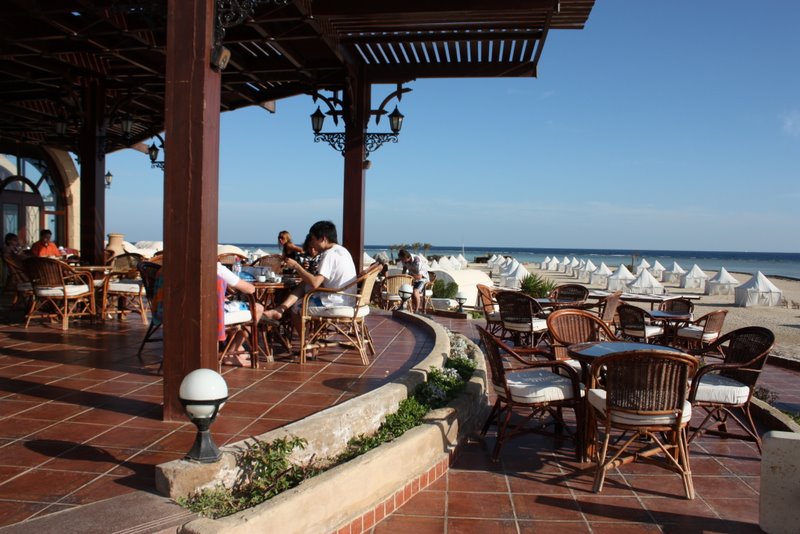 Speaking of the catering, that is also excellent. When I first visited Marsa Shagra in 2003 there was a small Bedouin bar on top of a small hill where you could drink and relax. That has now been replaced by a restaurant where great food is served buffet style. The staff are very proud of the food that they serve. This was at no time more evident than on New Year’s Eve, when they put on an enormous and extravagant spread that was a sight to behold. Dinner was delayed for a good hour or so as no-one wanted to spoil all their hard work by eating it!
Speaking of the catering, that is also excellent. When I first visited Marsa Shagra in 2003 there was a small Bedouin bar on top of a small hill where you could drink and relax. That has now been replaced by a restaurant where great food is served buffet style. The staff are very proud of the food that they serve. This was at no time more evident than on New Year’s Eve, when they put on an enormous and extravagant spread that was a sight to behold. Dinner was delayed for a good hour or so as no-one wanted to spoil all their hard work by eating it!
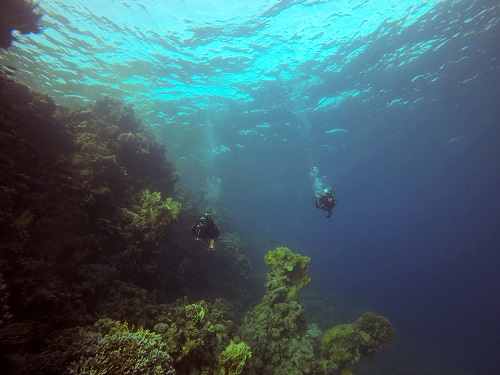 The Bedouin bar has now moved to the far end of the beach and is a great place to spend the evening relaxing and stargazing at the end of the day.
The Bedouin bar has now moved to the far end of the beach and is a great place to spend the evening relaxing and stargazing at the end of the day.
There is a choice of accommodation, once again to suit all tastes and pockets, ranging from simple but roomy tents through to en-suite guest houses with air conditioning. The bonus for those in the tents is that they are on the beach and look out onto the sea, so if you rise early you can watch the spectacular sunrises.
And as if all of this wasn’t enough, there are a number of other activities available, including a desert star gazing tour, camel and horse riding and quad biking (great fun on your off-gassing day).
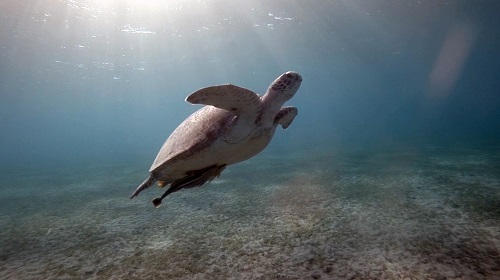 After a visit a few years ago I asked the group (about 15 of us that time) what they thought could be done to make the place any better. A lot of head scratching ensued. One person suggested it could be free (yeah, right), but really the only thing we could think of was that they could probably do a slightly better job of keeping people in the same group next to each other when they allocate lockers for your dive gear – but that is probably not down to them anyway, since some folks seem to ignore their allocated number and just go where they will. So, that was all we could come up with.
After a visit a few years ago I asked the group (about 15 of us that time) what they thought could be done to make the place any better. A lot of head scratching ensued. One person suggested it could be free (yeah, right), but really the only thing we could think of was that they could probably do a slightly better job of keeping people in the same group next to each other when they allocate lockers for your dive gear – but that is probably not down to them anyway, since some folks seem to ignore their allocated number and just go where they will. So, that was all we could come up with.
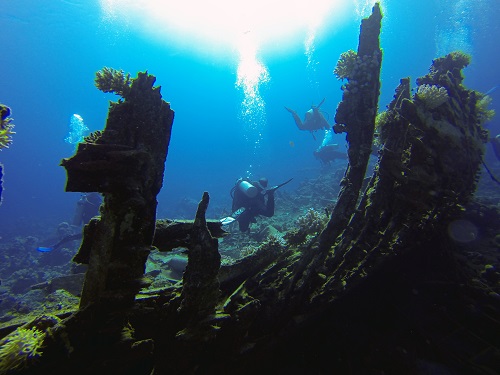 Hmm… maybe a few cushions to sit on when you go on day long truck dives… but now I’m just being picky.
Hmm… maybe a few cushions to sit on when you go on day long truck dives… but now I’m just being picky.
So there you have it. The dive club that I belong to is already planning a visit to the Red Sea at the end of the UK dive season, so it’s very likely we’ll be visting Marsa Shagra again. As for me, I fully expect that I will be returning in the not too distant future. There are plenty of other places to visit in the world, that’s true; but once you find somewhere this special, you’ll be drawn back time and time again – it’s like visiting an old and much loved friend.
For More details for holidays to Marsa Shagra, contact Oonasdivers by calling +44 (0)1323 648924, email info@oonasdivers.com or visit www.oonasdivers.com/egypt/resorts.
Scubaverse.com has teamed up with Oonasdivers to give one of you the chance to win a dive holiday to one of the Red Sea’s other southern dive villages, Marsa Nakari. To enter this awesome competition, click here.
Blogs
Northern Red Sea Reefs and Wrecks Trip Report, Part 3: The Mighty Thistlegorm

Jake Davies boards Ghazala Explorer for an unforgettable Red Sea diving experience…
Overnight, the wind picked up, making the planned morning dive a bit bumpy on the Zodiacs to the drop point on Thomas Reef. There, we would dive along the reef before descending through the canyon and then passing under the arch before ascending the wall with a gentle drift. The site provided great encounters with more pelagic species, including shoals of large barracuda, tuna, and bigeye trevally.
Once back on the boat, it was time to get everything tied down again as we would head back south. This time, with the wind behind us, heading to Ras Mohammed to dive Jackfish Alley for another great gentle drift wall dive before then heading up the coast towards the Gulf of Suez to moor up at the wreck of the Thistlegorm. This being the highlight wreck dive of the trip and for many onboard, including myself, it was the first time diving this iconic wreck. I had heard so much about the wreck from friends, and globally, this is a must on any diver’s list. Fortunately for us, there was only one other boat at the site, which was a rarity. A great briefing was delivered by Ahmed, who provided a detailed background about the wreck’s history along with all the required safety information as the currents and visibility at the site can be variable.

Kitting up, there was a lot of excitement on deck before entering the water and heading down the shoreline. Descending to the wreck, there was a light northerly current which reduced the visibility, making it feel more like the conditions that can be found off the Welsh coast. At 10m from the bottom, the outline of the wreck appeared as we reached the area of the wreck which had been bombed, as our mooring line was attached to part of the propeller shaft. Arriving on deck, instantly everywhere you looked there were many of the supplies which the ship was carrying, including Bren Carrier tanks and projectiles that instantly stood out.

We headed around the exterior, taking a look at the large propeller and guns mounted on deck before entering the wreck on the port side to take a look in the holds. It was incredible to see all the trucks, Norton 16H, and BSA motorcycles still perfectly stacked within, providing a real snapshot in time.

Overall, we had four dives on the Thistlegorm, where for all of the dives we were the only group in the water, and at times, there were just three of us on the whole wreck, which made it even more special, especially knowing that most days the wreck has hundreds of divers. Along with the history of the wreck, there was plenty of marine life on the wreck and around, from big green turtles to batfish, along with shoals of mackerel being hunted by trevally. Some unforgettable dives.

The final leg of the trip saw us cross back over the Suez Canal to the Gobal Islands where we planned to stay the night and do three dives at the Dolphin House for the potential of sharing the dive with dolphins. The site, which included a channel that was teeming with reef fish, especially large numbers of goatfish that swam in large shoals along the edge of the reef. These were nice relaxing dives to end the week. Unfortunately, the dolphins didn’t show up, which was okay as like all marine life they are difficult to predict and you can’t guarantee what’s going to be seen. With the last dive complete, we headed back to port for the final night where it was time to clean all the kit and pack before the departure flight the next day.

The whole week from start to finish on Ghazala Explorer was amazing; the boat had all the facilities you need for a comfortable week aboard. The crew were always there to help throughout the day and the chefs providing top quality food which was required after every dive. The itinerary providing some of the best diving with a nice mixture of wreck and reef dives. I would recommend the trip to anyone, whether it’s your first Red Sea liveaboard in the Red Sea or you’re revisiting. Hopefully, it’s not too long before I head back to explore more of the Red Sea onboard Ghazala Explorer.

To find out more about the Northern Red Sea reef and wrecks itineraries aboard Ghazala Explorer, or to book, contact Scuba Travel now:
Email: dive@scubatravel.com
Tel: +44 (0)1483 411590
Photos: Jake Davies / Avalon.Red
Blogs
Northern Red Sea Reefs and Wrecks Trip Report, Part 2: Wall to Wall Wrecks

Jake Davies boards Ghazala Explorer for an unforgettable Red Sea diving experience…
The second day’s diving was a day full of wreck diving at Abu Nuhas, which included the Chrisoula K, Carnatic, and Ghiannis D. The first dive of the day was onto the Chrisoula K, also known as the wreck of tiles. The 98m vessel remains largely intact where she was loaded with tiles which can be seen throughout the hold. The stern sits at 26m and the bow just below the surface. One of the highlights of the wreck is heading inside and seeing the workroom where the machinery used for cutting the tiles are perfectly intact. The bow provided some relaxing scenery as the bright sunlight highlighted the colours of the soft coral reef and the many reef fish.

Following breakfast, we then headed to the next wreck, which was the Carnatic. The Carnatic is an 89.9m sail steamer vessel that was built in Britain back in 1862. She ran aground on the reef back in 1869 and remains at 27m. At the time, she was carrying a range of items, including 40,000 sterling in gold. An impressive wreck where much of the superstructure remains, and the two large masts lay on the seafloor. The wooden ribs of the hull provide structures for lots of soft corals, and into the stern section, the light beams through, bouncing off the large shoals of glass fish that can be found using the structure as shelter from the larger predators that are found outside of the wreck.

The final wreck at Abu Nuhas was the Ghiannis D, originally called ‘Shoyo Maru,’ which was 99.5m long and built in Japan back in 1969 before becoming a Greek-registered cargo ship in 1980. The ship then ran aground on the reef on April 19th, 1983, and now sits at the bottom at a depth of 27m. Heading down the line, the stern of the ship remains in good condition compared to the rest of the hull. The highlight of the wreck, though, is heading into the stern section and down the flights of stairs to enter the engine room, which remains in good condition and is definitely worth exploring. After exploring the interior section of the ship, we then headed over to see the rest of the superstructure, where it’s particularly interesting to see the large table corals that have grown at the bow relatively quickly considering the date the ship sank. After surfacing and enjoying some afternoon snacks, we made sure everything was strapped down and secured as we would be heading north and crossing the Gulf of Suez, where the winds were still creating plenty of chop.

The next morning, it was a short hop to Ras Mohammed Nature Reserve for the next couple of days of diving. The 6am wake-up call came along with the briefing for the first site we would be diving, which was Shark & Yolanda. The low current conditions allowed us to start the dive at Anemone City, where we would drift along the steep, coral-filled wall. These dives involved drifts, as mooring in Ras Mohammed wasn’t allowed to protect the reefs. As a dive site, Shark & Yolanda is well-known and historically had a lot of sharks, but unfortunately not so many in recent years, especially not so early in the season. However, there was always a chance when looking out into the blue.

The gentle drift took us along the steep walls of the site, with plenty of anemone fish to be seen and a huge variety of corals. It wasn’t long into the dive before we were accompanied by a hawksbill turtle, who drifted with us between the two atolls before parting ways. Between the two reefs, the shallow patch with parts of coral heads surrounded by sand provided the chance to see a few blue-spotted stingrays that were mainly resting underneath the corals and are always a pleasure to see. With this being the morning dive, the early sunlight lit up the walls, providing tranquil moments. Looking out into the blue, there was very little to be seen, but a small shoal of batfish shimmering underneath the sunlight was a moment to capture as we watched them swim by as they watched us.

Towards the end of the dive, we stopped at the wreck of the Jolanda where the seafloor was scattered with toilets from the containers it was carrying. This provided a unique site to make a safety stop, which was also accompanied by a large barracuda slowly swimming by, along with a hawksbill turtle calmly swimming over the reef as the sun rays danced in the distance.
For the next dive, we headed north to the Strait of Tiran to explore the reefs situated between Tiran Island and Sharm El Sheik, which were named after the British divers who had found them. We started on Jackson before heading to Gordons Reef, where we also did the night dive. All the atolls at these sites provided stunning, bustling coral reefs close to the surface and steep walls to swim along, which always provided the opportunity to keep an eye out for some of the larger species that can be seen in the blue. Midwater around Jackson Reef was filled with red-toothed triggerfish and shoals of banner fish, which at times were so dense that you couldn’t see into the blue. Moments went by peacefully as we enjoyed the slow drift above the reef, watching these shoals swim around under the mid-afternoon sun.

The night dive at Gordon’s Reef was mainly among the stacks of corals surrounded by sand, which was great to explore under the darkness. After some time circling the corals, we came across what we were really hoping to find, and that was an octopus hunting on the reef. We spent the majority of the dive just watching it crawl among the reef, blending into its changing surroundings through changes in colour and skin texture. It’s always so fascinating and captivating to watch these incredibly intelligent animals, in awe of their ability to carry out these physical changes to perfectly blend into the reef. Before we knew it, it was time to head back to the boat to enjoy a well-deserved tasty dinner prepared by the talented chefs onboard.
Check in for the 3rd and final part of this series from Jake tomorrow!
To find out more about the Northern Red Sea reef and wrecks itineraries aboard Ghazala Explorer, or to book, contact Scuba Travel now:
Email: dive@scubatravel.com
Tel: +44 (0)1483 411590
Photos: Jake Davies / Avalon.Red
-

 News3 months ago
News3 months agoHone your underwater photography skills with Alphamarine Photography at Red Sea Diving Safari in March
-

 News3 months ago
News3 months agoCapturing Critters in Lembeh Underwater Photography Workshop 2024: Event Roundup
-

 Marine Life & Conservation Blogs2 months ago
Marine Life & Conservation Blogs2 months agoCreature Feature: Swell Sharks
-

 Blogs2 months ago
Blogs2 months agoMurex Resorts: Passport to Paradise!
-

 Blogs2 months ago
Blogs2 months agoDiver Discovering Whale Skeletons Beneath Ice Judged World’s Best Underwater Photograph
-

 Gear Reviews3 months ago
Gear Reviews3 months agoGear Review: Oceanic+ Dive Housing for iPhone
-

 Marine Life & Conservation2 months ago
Marine Life & Conservation2 months agoSave the Manatee Club launches brand new webcams at Silver Springs State Park, Florida
-

 News3 months ago
News3 months agoWorld’s Best Underwater Photographers Unveil Breathtaking Images at World Shootout 2023


